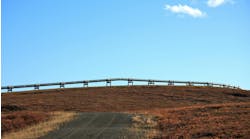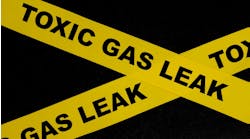THIS MONTH'S PUZZLER
Readings from two radar level transmitters on our LPG storage tank markedly disagree. The radar elements are installed in stillwells connected to a large pressurized tank currently operating at about 800 kPa (g) and 24°C. The gas feeds burners via underground piping. Right now, demand is so low there's no need to use the vaporizer, evaporation suffices. What could cause these elements to differ so radically? Should we be concerned? Is there anything that can be done to line up the level transmitters?
PAINT IT BLACK
The vaporizer is not being used because ambient conditions are sufficient to evaporate enough LPG to keep up with demand. The only other source I can think of is solar. What you need to decide is whether this is a normal operating mode and, if so, then what effect this will have on level measurement in the tank.
For the radar gauges to read the same, they have to be in communication with the tank and the level on each side of the tank must be the same. This is just the physical stuff. I am assuming that the transmitters are calibrated identically.
Start by looking at the stillwells. If they are too small, they won't communicate well with the tank. Heating on one side of the tank, and one stillwell, could cause thermal expansion leading to a significant difference between what the two gauges are reading.
Is this a legitimate startup problem? You bet. These gauges are meant to complement each other — so, if one transmitter fails, you won't have to shut down the plant to replace it.
I suggest you check the transmitters to eliminate calibration differences. Then, calculate the LPG being produced. If solar power is adequate, consider painting the tank and evaporator black to improve heating; this could improve transfer to the stillwells.
Look carefully at the orientation of the equipment. Mis-orientation is a common error with cryogenic heat exchangers. They need to be oriented towards the sun and away from shadows — in the northern hemisphere, that's with a southern exposure; in the southern hemisphere, a northern exposure.
A heater accumulating ice is a bad sign. One place I worked at installed their N2 heater in the shadows on the north side of the building; they had to post a sign warning of falling ice. They even ran short of nitrogen!
If solar heating won't supply your needs then you need to see how the radar gauge performs with the vaporizer operating. This might mean putting the problem on the backburner until there's sufficient demand. The last thing you want to do is install larger stillwells or pull the radar transmitters for a bench test.
Dirk Willard, contract staff engineer
Hemlock Semiconductor, Hemlock, Mich.
DECEMBER'S PUZZLER
Our contact HCl condenser/scrubber operates with two 1,750-rpm circulating pumps and one spare at a pressure of about 12 psia. There are three 350-mm suction lines. Their bells (90° elbows) reach to 200 mm from the tank bottom; the bells' exteriors are only 280-mm apart! The suction length is about 25 ft with four short-radius elbows and a butterfly valve. The low/low pump trip is set at 50%, about 6.6 ft from bottom, while the low alarm is at 60%, about 7.5 ft. The suctions are separate but the discharges connect to a common manifold. The two operating pumps supply a total of 5,500 gallons per minute to a cooling water exchanger and then to either a 300-mm circulation spray nozzle (40 ft above tank bottom) or three 80-mm nozzles. With the pumps running, level drops from 55% to 42% during circulation when the packing is wetted. The fiber-glass piping rumbles from the suction lines to the spray nozzles. One pipe support for the 300-mm spray nozzle already is broken. Are we dealing with cavitation or something else? How can we address this situation?
Send us your comments, suggestions or solutions for this question by November 12, 2010. We'll include as many of them as possible in the December 2010 issue and all on CP.com. Send visuals — a sketch is fine. E-mail us at [email protected] or mail to Process Puzzler, Chemical Processing, 555 W. Pierce Road, Suite 301, Itasca, IL 60143. Fax: (630) 467-1120. Please include your name, title, location and company affiliation in the response.
And, of course, if you have a process problem you'd like to pose to our readers, send it along and we'll be pleased to consider it for publication.


